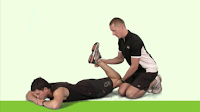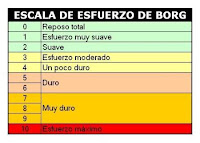TASK 1
1. What is the FNP? Explain all its phases and give an example for the quadriceps and another for harmstrings.
1. FNP refers to a set of proprioceptive neuromuscular
facilitation (PNF) techniques. They are therapeutic methods carried out in
order to obtain specific responses of the neuromuscular system from the
stimulation of the organic proprioceptors.
PHASES:
For this
phases you need a partner
- 1st:
Passive stretching: You have to stretch the muscle of your partner, the muscle has to
be at the limit of the tension (20 seconds)
- 2nd:
Isometric stretch: You have to contract the muscle, your parter has to block
the movement (8 seconds)
- 3rd:
Relax: In this phase you have to relax the muscle of your partner, for 5
seconds
- 4th:
Passive stretching again: In this phases you have to repeat the first phase,
but now, you should feel more
flexibility.
Quadriceps: The person who is stretching
must be against the wall, the partner has to take the leg and lift it slowly
with the hip stuck to the ground, do this for 20 seconds, then, the parter has
to do strength and you have to block the movement, this for 8 seconds, later, rest
for 5 seconds, and repeat the first phase.
Harmstrings: One person of the couple has to
be sitted on the floor like in the image. The other person of the couple has
to push him from the back, do this for 20 seconds, then the partner has to do
strength, and the person in the
floor has to blocked this movement, later, rest for 5 seconds, and repeat the first phase.
2. Explain the General Syndrome of Adaptation and all its phases. Give an example.
2. GAS is the three-stage process that
describes the physiological changes the body goes through when under stress.
PHASES:
1. Alarm reaction stage:
The alarm reaction stage refers to the
initial symptoms the body experiences when under stress. You may be familiar
with the “fight-or-flight” response, which is a physiological response to
stress. This natural reaction prepares you to either flee or protect yourself
in dangerous situations. Your heart rate increases, your adrenal gland releases
cortisol (a stress hormone), and you receive a boost of adrenaline, which
increases energy.
EXAMPLE: If you are sleeping at night and you heard one
sound, you can go and see what is it (fight) or stay in your bed frightened (flight)
2. Resistance stage:
After
the initial shock of a stressful event and having a fight-or-flight response,
the body begins to repair itself. It releases a lower amount of cortisol, and
your heart rate and blood pressure begin to normalize. Although your body
enters this recovery phase, it remains on high alert for a while. If you
overcome stress and the situation is no longer an issue, your body continues to
repair itself until your hormone levels, heart rate, and blood pressure reach a
pre-stress state.
EXAMPLE: Frustration, poor
concentration
3. Exhaustion stage:
This stage is the
result of prolonged or chronic stress. Struggling with stress for long periods
can drain your physical, emotional, and mental resources to the point where
your body no longer has strength to fight stress. You may give up or feel your
situation is hopeless.
EXAMPLE: Fatigue, burnout
3. Explain the Threshold Law by Arnold Schultz. Illustrate with an example.
3. This theory starts from the existence of a threshold or a minimum estimate necessary for some modification, improvement or adaptation to occur in the organism. This is a very personal issue. There is also a maximum tolerance or point from which only fatigate and overtraining occurs. According to this law, adptation takes place as a consequence of physical efforts proposed in a consistent and adequate manner so that the organism assimilates them progressively. In the training we can find:
1. Stimulus below the threshold or f excessively low intensity: They don't have consequences on the training
2. Effects above the threshold
EXAMPLE: an example can be running 15 minutes two or
three days a week.
4. What is the training load and what are its components? Explain them and give an example of each component.
4.Training
load is a textual
feedback on the strenuousness of a single training session. Training load calculation
is based on the consumption of critical energy sources (carbohydrates and
proteins) during exercise.
COMPONENTS:
- The intensity: When talking about intensity, we refer
to the qualitative aspects (quality) of the load, which results from:
The number of repetitions
The speed of execution
The complexity of the exercise
The duration of the breaks.
EXAMPLE:
- The volume: The total amount of activity performed in the training.
EXAMPLE: The time you have worked in a day.
- The dynamics of the charges: Rhythmic
succession with ondulatory character, the reduction of parameters and the
increase of others. these parameters, volume and intensity, will only be
possible to increase them at the same time up to a particular degree.
- The duration: Time during which the training stimulus
has an effect on the organism.
EXAMPLE: 1 hour, 2 hours of work.
- The recuperation: Period that
we let between stimulus and stimulus for the body to rest, either in the
session or between sessions.
EXAMPLE: 2 minutes, 30 seconds.
- The density: Frequency with which the
athlete receives stimuli per unit of time
EXAMPLE: Reduce the tiredness completely
- The repetitions: Number of
times that produces an stimulation in each session.
EXAMPLE: 1 serie, 2 series.
5. Explain the principles of training according to the classification of Oliver (1985) and Zintl (1991)
5. Classification of the fundamental principles of training according to Oliver
- Related to the training stimulus:
1. Variety
2. Continuity 3. Progression
- Related to the systems to which the training stimulus is directed:
4. Specificity
5. Multilaterality
6. Specialization
- Related to the response to the stimulus:
7. Individualization
5. Classification of the fundamental principles of training according to Zintl
1. Effective stimulation of the load
2. Progressive increase of the load
3. Variety of the load
- Guarantee the adaptation:
4. Optimum relationship between load and recovery
5. Repetition and continuity
6. Periodization
8. Progressive specialization
9. Alternation


